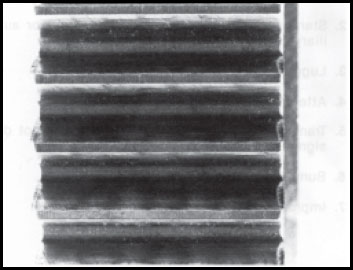Novēršana Eaton Transmisijas Gears & vārpstas
kas ir pretrunā Gears
Snubbing and clashing gears while shifting are frequent abuses to which unsynchronized transmissions are subjected. Light snubbing will do little damage. The real damage is done by the hard clash shift caused by engaging gears which are far out of synchronization. This can break pieces of metal from the ends of the clutching teeth. Clashing gears can be traced to one of three causes:
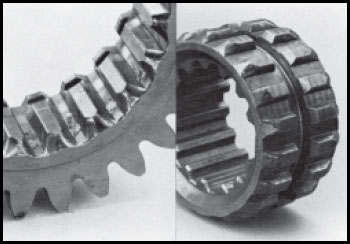
Noraida Clutching Gear zobi
1. nepareiza nobīde
This applies to drivers who are not familiar with the shift pattern or have not learned the RPM spread between shifts.
2. sajūgs
Clashing when starting up in first or reverse gear can be caused by insufficient clutch clearance or a dragging clutch not releasing properly. This makes the transmission countershafts and mainshaft gears continue rotating while the clutch pedal is depressed. Clashing results when the nonrotating sliding clutch is forced to mesh with a rotating mainshaft gear. Double clutching during lever shifts will also reduce snubbing and clashing.
3. inerces spēks
Countershafts un mainshaft zobrati parasti ilgst no 3 līdz 5 sekundes, lai apturētu rotējot pēc tam, kad sajūgs ir atvienots. Mēģinot acs sajūgs rīkus ar mainshaft rīku pirms mainshaft rīku apstājas radīs žvadzinot. Ja transmisija nav aprīkots ar sajūga bremzi vai countershaft bremzi, tas ir nepieciešams, lai apturētu dažas sekundes pēc sajūga pedāli, pirms mēģināt sākotnējo iesaisti pārnešanas.
Ražošanas Marks
Sometimes gears are replaced or thought to be defective because of marks left on the gear by manufacturing processes. Šie plankumi, tomēr, do not contribute to gear failure and the gear should not be replaced because of these marks.
virsma Marks
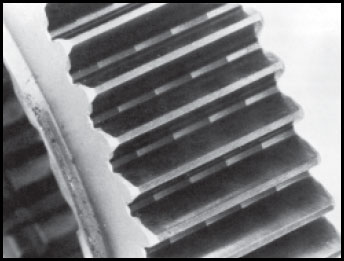
These are cutting marks or lines formed during the initial cutting of the gear teeth. Hob marks on the tooth face will be removed by the shaving process, but hob marks in the root of the tooth will most likely remain, and may be found even on gears with much wear on them.
Skūšanās Marks
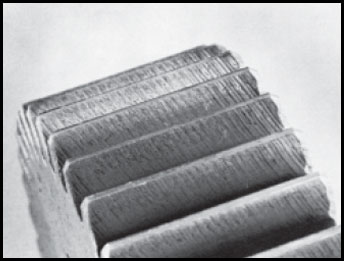
The shaving operation leaves distinct diagonal marks on the face of the gear tooth. These marks can be distinguished from scoring marks by the fact they are diagonal, while scoring marks are more nearly vertical. Most shaving marks are removed during normal gear operation.
Gear Rattle tukšgaitā
Mainshaft gears are designed to have a specified amount of axial clearance which allows them to rotate freely on the mainshaft. The amount of clearance is governed by the use of washers. Aptuvens tukšgaitā dzinējs var izveidot vibrācijas, causing the mainshaft gears to rattle as they strike mating gears. This condition can usually be cured by improving the idling characteristics of the engine. Tolerance washers may have to be changed to bring the axial gear clearance to within tolerance on high mileage units. See the service manual for procedure and specifications.
Shaft Twist un sabrukums
Failure of transmission shafts through fracturing or twisting is caused when stresses are imposed on them which are greater than they were designed to withstand. The main causes for these failures are:
- Nepareizi clutching metodes.
- Sākot pārāk augsts rīku.
- lugging.
- Mēģinot sākt ar bremzēm aizslēgtas.
- Transmission used for application it was not designed to withstand.
- Mutuļošana vērā dokā, ja pamatni.
- Nepareiza montāža regulējamu 5. riteņa.
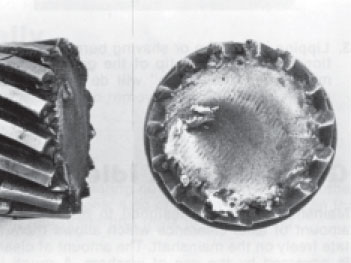
lauzta Mainshaft
Tāpat kā ar zobratu zobiem, shafts may fracture as a result of fatigue or impact.
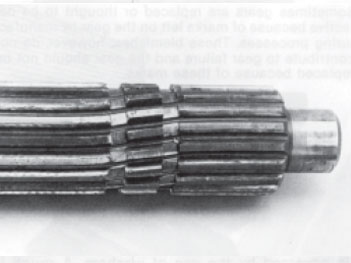
Twisted Mainshaft
Loads not severe enough to cause shaft fractures may cause the shaft to twist.
jebkurš pārraides daļa Jums ir nepieciešams mums tas ir! Tajā pašā dienā kuģniecības pieejams, vispasaules.
NEED FREE atbalsts kādam no mūsu ekspertiem?

